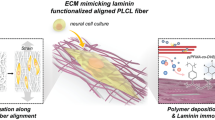We compared the capability of human fibroblasts to populate porous polycaprolactone (PCL) scaffolds modified during fabrication with surface-active agents Triton Х-100 (type 1 scaffold) and polyvinylpyrrolidone (type 2 scaffold). The mean fiber diameter in both scaffolds was almost the same: 3.90±2.19 and 2.46±2.15 μ, respectively. Type 1 scaffold had higher surface density and hydrophilicity, when type 2 scaffold was 1.6 times thicker. The cells were seeded on the scaffolds by the dynamic seeding technique and then cultured in Petri dishes with nutrient medium in a humid atmosphere. During 3-day culturing, no cell release from the matrix was noted. DAPI staining proved the presence of cells in both scaffolds. However, in type 1 scaffold the cells populated the whole thickness, while in type 2 scaffold, the cells were present only in the superficial layer. These findings suggest that PCL scaffolds modified with Triton Х-100 or polyvinylpyrrolidone are not cytotoxic, but the structure of the scaffold treated with Triton Х-100 is more favorable for population with cells.
Similar content being viewed by others
References
Antonova LV, Sevostyanova VV, Kutikhin AG, Velikanova EA, Matveeva VG, Glushkova TV, Mironov AV, Krivkina EO, Barbarash OL, Barbarash LS. Influence of bFGF, SDF-1 a, or VEGF incorporated into tubular polymer scaffolds on the formation of small-diameter tissue-engineered blood vessel in vitro. Vestn. Transplantol. Isskust. Organov. 2018;20(1):96-109. Russian.
Arutyunyan IV, Tenchurin TKh, Kananykhina EY, Chernikov VP, Vasyukova OA, Elchaninov AV, Makarov AV, Korshunov AA, Burov AA, Podurovskaya YL, Chuprynin VD, Uvarova EV, Degtyarev DN, Shepelev AD, Mamagulashvili VG, Kamyshinskiy RA, Krasheninnikov SV, Chvalun SN, Fatkhudinov TKh. Nonwoven polycaprolactone scaffolds for tissue engineering: the choice of the structure and the method of cell seeding. Geny Kletki. 2017;12(1):62-71. Russian.
Afanasiev SA, Muslimova EF, Nashchekina YA, Nikonov PO, Rogovskaya YV, Bolbasov EN, Tverdokhlebov SI. Peculiarities of Cell Seeding on Polylactic Acid-Based Scaffolds Fabricated Using Electrospinning and Solution Blow Spinning Technologies. Bull. Exp. Biol. Med. 2017;164(2):281-284. doi: https://doi.org/10.1007/s10517-017-3973-x
Akhmedov ShD, Lugovsky VA, Andreev SL, Rebenkova MS, Rogovskaya YV, Skurihin IM, Vecherskiy YuYu, Afanasyev SA. Effect of decellularization with sDs and Triton X-100 detergent solutions on the strength capacities of small caliber arteries. Geny Kletki. 2015;10(2):61-64. Russian.
Kiselevskii MV, Anisimova NYu, Shepelev AD, Tenchurin TKh, Mamagulashvili VG, Krasheninnikov SV, Grigor;ev TE, Lebedinskaya OV, Chvalun SN, Davydov MI. Mechanical properties of bioengineering prosthesis of the trachea based on polymeric ultrafibrous material. Ross. Zg. Biomekhaniki. 2016;20(2):116-122. Russian.
Kochegura TN, Efimenko AY, Akopyan ZhA, Parfyonova EV. Stem cell therapy of heart failure: clinical trials, problems and perspectives. Klet. Transplantol. Tkan. Inzhener. 2010;5(2):11-18. Russian.
Nashchekina YA, Nikonov PO, Mikhailov VM, Pinaev GP. Distribution of bone-marrow stromal cells in a 3D scaffold depending on the seeding method and the scaffold inside a surface modification. Cell Tissue Biology. 2014;8(4):313-320.
Rodina AV, Tenchurin TKh, Saprykin VP, Shepelev AD, Mamagulashvili VG, Grigor’ev TE, Moskaleva EYu, Chvalun SN, Severin SE. Proliferative and Differentiation Potential of Multipotent Mesenchymal Stem Cells Cultured on Biocompatible Polymer Scaffolds With Various Physicochemical Characteristics. Bull. Exp. Biol. Med. 2017;162(4):488-495. doi: https://doi.org/10.1007/s10517-017-3646-9
Sytina EV, Tenchurin TH, Rudyak SG, Saprykin VP, Romanova OA, Orehov AS, Vasiliev AL, Alekseev AA, Chvalun SN, Paltsev MA, Panteleyev AA. Comparative biocompatibility of nonwoven polymer scaffolds obtained by electrospinning and their use for development of 3D dermal equivalents. Mol. Med. 2014;(6):38-47. Russian.
Shved YuA, Kukhareva LV, Zorin IM, Solovjov AYu, Blinova MI, Bilibin AYu, Pinaev GP. Elaboration of biodegradable polymer substrate for cultivation of human dermal fibroblasts. Tsitologiya. 2006;48(2):161-168. Russian.
Melchels FPW, Domingos MAN, Klein TJ, Malda J, Bartolo PJ, Hutmacher DW. Additive manufacturing of tissues and organs. Prog. Polym. Sci. 2012;37(8):1079-1104.
Orekhov AS, Klechkovskaya VV, Kononova SV. Low-voltage scanning electron microscopy of multilayer polymer systems. Crystallogr. Rep. 2017;62(5):710-715.
Remya KR, Chandran S, Mani S, John A, Ramesh P. Hybrid polycaprolactone/polyethylene oxide scaffolds with tunable fiber surface morphology, improved hydrophilicity and biodegradability for bone tissue engineering applications. J. Biomater. Sci. Polym. Ed. 2018;29(12):1444-1462.
Schindelin J, Arganda-Carreras I, Frise E, Kaynig V, Longair M, Pietzsch T, Preibisch S, Rueden C, Saalfeld S, Schmid B, Tinevez JY, White DJ, Hartenstein V, Eliceiri K, Tomancak P, Cardona A. Fiji: an open-source platform for biological-image analysis. Nat. Methods. 2012;9(7):676-682.
Author information
Authors and Affiliations
Corresponding author
Additional information
Translated from Kletochnye Tekhnologii v Biologii i Meditsine, No. 2, pp. 143-148, June, 2020
Rights and permissions
About this article
Cite this article
Afanasiev, S.A., Muslimova, E.F., Nashchekina, Y.A. et al. Peculiarities of Cell Seeding on Electroformed Polycaprolactone Scaffolds Modified with Surface-Active Agents Triton X-100 and Polyvinylpyrrolidone. Bull Exp Biol Med 169, 600–604 (2020). https://doi.org/10.1007/s10517-020-04936-0
Received:
Published:
Issue Date:
DOI: https://doi.org/10.1007/s10517-020-04936-0




